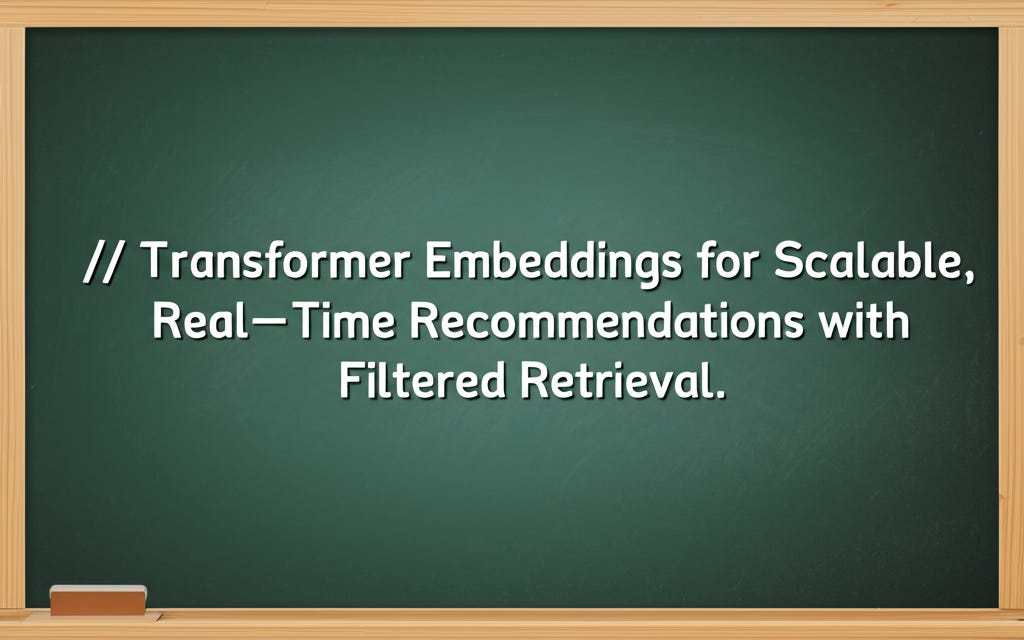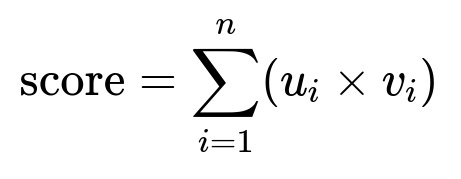ML Case-study Interview Question: Transformer Embeddings for Scalable, Real-Time Recommendations with Filtered Retrieval.
Case-Study question
A large digital platform hosts millions of premium items and a hundred million user-uploaded items. The goal is to improve content discovery by personalizing recommendations for each user. The existing method uses collaborative filtering, but it lacks personalization depth. A new Transformer-based approach outputs vector embeddings for users and items. Your task: design an embedding-based retrieval solution that can handle real-time recommendations with user-level filters (for example, language or content format) and generate relevant suggestions at low latency. Propose a scalable architecture, outline how you would store, update, and retrieve embeddings, ensure query-time faceting, maintain quick response times under traffic, and handle daily or weekly model updates.
Architecture, Data Flow, and Storage
The system stores user and item embeddings in two separate indices or tables. One index maps each user ID to its embedding. Another index holds each item's embedding and metadata fields for filtering (like language or region). A client service retrieves the user's embedding by looking up the user ID, then queries for the top items that match this embedding. Each query includes user-specific filters.
For scoring, the core formula is the dot product between user and item embeddings:
Here, n is the dimensionality of the embedding. u_i represents the user embedding component i, and v_i represents the item embedding component i.
This dot product is computed inside the search engine's script scoring. Negative scores are shifted by a constant to ensure they remain non-negative if your system disallows negative values.
The system must support nightly or weekly ingestion of new user and item embeddings. The recommendation model is large and needs a careful retraining cadence, balancing performance and freshness. A big-data framework can generate embeddings and push them to the search cluster via a batch pipeline.
Handling Faceted Queries
The retrieval engine must prefilter items based on user-level or row-level facets (for example, a user’s language preference or item category). Using a script-based scoring query, you do the following:
Filter out items with fields that do not match the user or row constraints.
Compute the dot product for remaining items.
Return top-N items.
When multiple distinct rows (like “Comedy Titles for You” and “Audiobooks for You”) are needed, the multi-search API can group these queries to reduce overhead.
System Configuration
A search cluster must distribute data across shards to handle large-scale embeddings and metadata. Each shard is a logical partition. Replica shards provide redundancy. Smaller shard sizes can sometimes reduce query latency, but over-sharding can cause overhead. When updating indices, create a new index with the new data, then move the alias from the old index to the new one to avoid downtime. The cluster can be spread across multiple nodes for resilience.
Serving Flow
The user makes a request for recommendations.
The service fetches the user embedding using the user’s ID from the first index/table.
The service forms a script scoring query with the user embedding, plus filtering conditions, against the second index/table of items.
The retrieval engine returns scored items. The service post-processes them (for example, removing duplicates).
The final list is sent back to the front end.
User embeddings can update daily to capture changes in behavior, while item embeddings can update weekly if item features are relatively static. Keeping all data in one system simplifies maintenance. As long as the overhead is acceptable, it avoids synchronization issues that arise when item or user data is split across multiple databases.
Load Testing and Results
Load tests ensure the system handles projected traffic with minimal latency. Varying shard counts, dataset sizes, and filter complexity helps find performance bottlenecks. In a production environment, the system might serve tens of requests per second with latency under 100 ms at the 95th percentile.
In an A/B experiment, the embedding-based approach outperformed the old system by increasing user clicks, session length, and overall content engagement. These improvements proved the embedding-based retrieval pipeline’s business value.
Follow-up Question 1
How do you handle near-real-time updates if item embeddings or metadata change frequently?
Answer Explanation
Frequent changes require partial updates or real-time indexing. Some search engines lack true in-memory partial updates, forcing you to reindex entire documents. To reduce downtime, use rolling updates with index aliases. If real-time performance is critical, consider specialized vector databases that allow partial in-memory updates or real-time merges. The best approach depends on how often data changes. If you only need daily or weekly ingestion, a batch reindexing pipeline is fine. If item metadata or embeddings change every second, a streaming pipeline to a database that supports incremental writes might be necessary.
Follow-up Question 2
Why not store the user embeddings in a traditional database and only store the item embeddings in the search cluster?
Answer Explanation
Storing data in multiple systems complicates synchronization. Each user embedding must remain consistent with the item embedding space. If the user embedding is in one database and item embeddings are in another, version mismatches can arise. It also increases operational overhead. A single source of truth keeps query logic simpler. You might do it for specialized reasons, like performance or cost, but an integrated approach avoids consistency pitfalls.
Follow-up Question 3
Why choose dot product over other similarity measures like cosine similarity or Euclidean distance?
Answer Explanation
Dot product is fast to compute and works well with embedding magnitudes that carry meaningful information. Cosine similarity normalizes vectors, focusing only on direction. Euclidean distance measures absolute distance in the embedding space. The choice depends on the model’s training objective. If the model trains with dot product as the similarity function, that usually translates directly to the query-time scoring. If your training objective used cosine similarity, you might adopt that measure. Each approach can lead to different results based on how the embeddings were learned.
Follow-up Question 4
How do you ensure the model remains robust against user preference drift?
Answer Explanation
Embed user behavior signals in daily or weekly updates. User embeddings must capture recent actions so new preferences appear quickly in recommendations. A well-defined retraining schedule addresses slow drift. For abrupt changes in taste, partial finetuning or incremental updates to the user embedding are valuable. Regularly track metrics like click-through rate or session length to see if the model’s performance degrades over time. That signals the need to retrain more frequently.
Follow-up Question 5
How would you handle ranking after retrieving the top candidates from the embedding-based system?
Answer Explanation
You can apply a reranker model that refines the top candidates. The reranker might use additional features like real-time user context, item metadata, or social signals. It evaluates each candidate more deeply than a simple vector similarity measure. For example, a lightweight neural model or gradient boosted trees can provide final ordering. This multi-stage approach (candidate generation + reranking) balances speed (fast retrieval) and accuracy (contextual ranking).
Follow-up Question 6
What if new items have no historical usage data for embedding generation?
Answer Explanation
Items without usage data are cold-start items. You could assign them embeddings based on metadata features like category, text data, or tags. A pretrained embedding model can represent text or category semantics. Another option is to place them in a random exploration bucket so the system can gather interactions. Hybrid methods combine content-based signals and collaborative signals once enough user behavior data accumulates.
Follow-up Question 7
How do you decide on the ideal shard size?
Answer Explanation
Empirical testing is crucial. Overly large shards can cause slow queries, while very small shards lead to excessive overhead. Recommendations from search engine providers are guidelines, but you must test with real data. Monitor p95 or p99 latencies under realistic traffic. If performance degrades as shards grow, reduce the shard size. Adjust the number of nodes, total shards, and replication factor to balance fault tolerance, ingestion speed, and query latency.
Follow-up Question 8
How do you analyze A/B test results to confirm the new system’s improvement?
Answer Explanation
Define success metrics like click-through rate or reading duration. Randomly split traffic between the old and new systems. Gather data until the sample is statistically large enough. Then calculate metrics like average clicks per user, proportion of users who click at least once, or time spent engaging with content. Conduct hypothesis testing (for example, t-test) to ensure improvements are statistically significant. Confirm the new system’s performance holds for various user segments (new vs. returning users, different geographies, etc.).
Follow-up Question 9
How do you manage complex filter logic that changes by row (like “Not This Category” for row A but “Only This Category” for row B)?
Answer Explanation
Use a multi-search approach or a combined query that includes multiple boolean clauses for each row. Each row can specify a unique combination of filters. The retrieval engine then runs these subqueries concurrently or in one request if multi-search is supported. Each subquery has its own must, must_not, and filter clauses, letting you manage row-level constraints without complicated branching code. This method scales well if your system can handle multiple queries in parallel.
Follow-up Question 10
How would you handle the scenario where dot product scores can be negative?
Answer Explanation
Some systems disallow negative scores in custom ranking. You can shift scores by adding a constant offset to ensure they are non-negative. If your embedding space relies on negative correlations, ensure the offset is large enough so the entire distribution becomes positive. The offset’s value should preserve relative ranking (higher dot products remain higher after shifting). Verify that the shift does not adversely affect how tie-breaking or other ranking rules are applied.
Follow-up Question 11
What is the approach if you want to incorporate dynamic user behavior signals in near-real-time (for example, immediate item clicks)?
Answer Explanation
One approach is storing real-time user signals in a fast in-memory store. You can feed these signals to a smaller contextual reranker. Another approach is streaming partial updates to the user embedding if your system supports it. If that is not feasible, you can maintain a short-term cache of user interactions. The candidate set is still fetched from the core embedding-based system. Then the short-term signals refine or reorder the final results at the application layer.
Follow-up Question 12
Why not just rely on standard collaborative filtering?
Answer Explanation
Collaborative filtering alone struggles with new users or new items. It also offers limited flexibility for faceted queries (for example, filtering by language or region). Embeddings let you encode additional semantics and handle items or users lacking extensive interaction data. They also support direct similarity calculations. This approach can scale better, especially if you have a large item catalog and want more personalized or specialized filtering at runtime.
Follow-up Question 13
What final checks or monitoring do you keep in place to ensure system stability?
Answer Explanation
Set up monitors for query latency at high percentiles, error rates, and resource utilization. Track ingestion jobs to confirm that new embeddings arrive on schedule. Monitor memory and CPU usage on the search nodes. Implement alerting if any metric crosses thresholds, for example, p95 latency exceeding 100 ms. Keep logs of queries and scoring scripts in case you need to debug or optimize.



